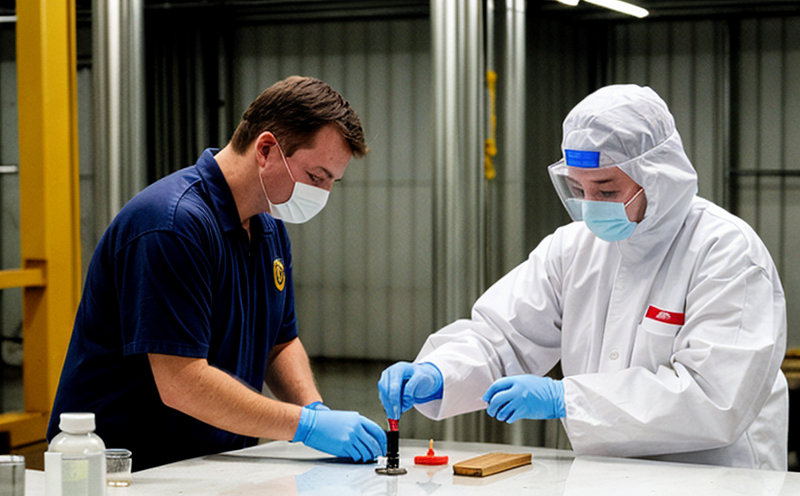ASTM D5276 Combined Drop and Temperature Test
The ASTM D5276 Combined Drop and Temperature Test is a critical procedure used to evaluate the impact resistance of packaging materials under varying environmental conditions. This test is particularly important for ensuring that packaging meets the rigorous demands placed on it in real-world environments, such as shipping, storage, and handling.
During this test, specimens are subjected to controlled temperature cycles followed by a drop test from a specified height. The purpose of this combined method is to simulate the stresses packaging materials might experience during transit or storage while also accounting for potential environmental factors like heat or cold exposure.
The ASTM D5276 protocol requires that samples be exposed to defined temperature ranges and held at these temperatures for specific durations before being subjected to a drop impact. The test is designed to evaluate the integrity of packaging materials by assessing whether they can withstand both thermal shock and mechanical stress simultaneously.
For this test, it's essential to consider not just the physical properties of the material itself but also how those properties interact with other components in the package (such as cushioning foams or adhesives). Additionally, the design and construction of the packaging play a crucial role in determining its performance during the combined drop and temperature cycle.
The ASTM D5276 protocol is widely recognized within industries reliant on robust packaging solutions. It ensures that products are protected effectively throughout their supply chain journey, thereby enhancing product quality and customer satisfaction.
Given the complexity of real-world conditions faced by packaged goods during transportation and storage, understanding how different environmental factors affect packaging materials becomes paramount. By conducting ASTM D5276 tests, manufacturers can gain valuable insights into which types of packaging are best suited for specific applications based on their ability to withstand thermal shock combined with mechanical stress.
This testing method helps identify potential weaknesses or strengths in current packaging designs early enough so that necessary adjustments can be made before mass production begins. This proactive approach ensures higher quality standards across all stages of product development and distribution, ultimately leading to more reliable and efficient supply chains.
Benefits
The ASTM D5276 Combined Drop and Temperature Test offers several key advantages for manufacturers and suppliers who rely on high-quality packaging solutions:
- Enhanced Product Protection: Ensures that packaged goods are adequately protected against damage during transit or storage.
- Better Quality Assurance: Provides detailed information about the performance of various materials under simulated real-world conditions, enabling better decision-making regarding material selection and design optimization.
- Increased Customer Satisfaction: By ensuring that packages can withstand both thermal and mechanical stresses, this testing method contributes to improved product quality and customer satisfaction.
In summary, the ASTM D5276 Combined Drop and Temperature Test serves as an indispensable tool for maintaining high standards in packaging design and manufacturing processes.
International Acceptance and Recognition
The ASTM D5276 Combined Drop and Temperature Test is internationally recognized and accepted by regulatory bodies around the world. Its widespread adoption indicates its significance in ensuring product safety and compliance with global standards.
This test method has been incorporated into numerous national and international standards, including ISO, EN, ASTM, and IEC. For example:
| Standard | Description |
|---|---|
| ASTM D5276-18 | Procedure for Determining the Resistance of Packaging Materials to Combined Drop and Temperature Cycles |
| ISO 3694:1990 | Plastics—Determination of resistance to impact under flexure in a controlled atmosphere |
| EN ISO 2578 | Determination of the drop-weight impact strength of plastics by means of pendulum tester (optional temperature conditioning) |
The consistent use of ASTM D5276 across different regions underscores its reliability and relevance in assessing packaging performance. Regulatory authorities from countries like the United States, Europe, China, Japan, and others have implemented this test as part of their quality assurance processes.
By aligning with international standards such as ASTM D5276, companies demonstrate their commitment to maintaining high-quality production practices that meet global expectations for safety and effectiveness. This alignment also facilitates smoother trade between nations by ensuring compatibility among different testing methodologies.
Use Cases and Application Examples
- Bottled Beverages: Ensuring that bottles maintain their integrity during shipping across various climates.
- Liquid Pharmaceuticals: Verifying the durability of containers in hot or cold storage facilities.
- Fragile Electronics: Assessing protective packaging effectiveness for devices being transported internationally.
- Perishable Foods: Checking how well packaging protects perishables from both temperature extremes and impacts during transit.
The versatility of ASTM D5276 allows it to be applied across multiple sectors, making it an invaluable tool for various industries seeking to enhance product protection through rigorous testing methods.





